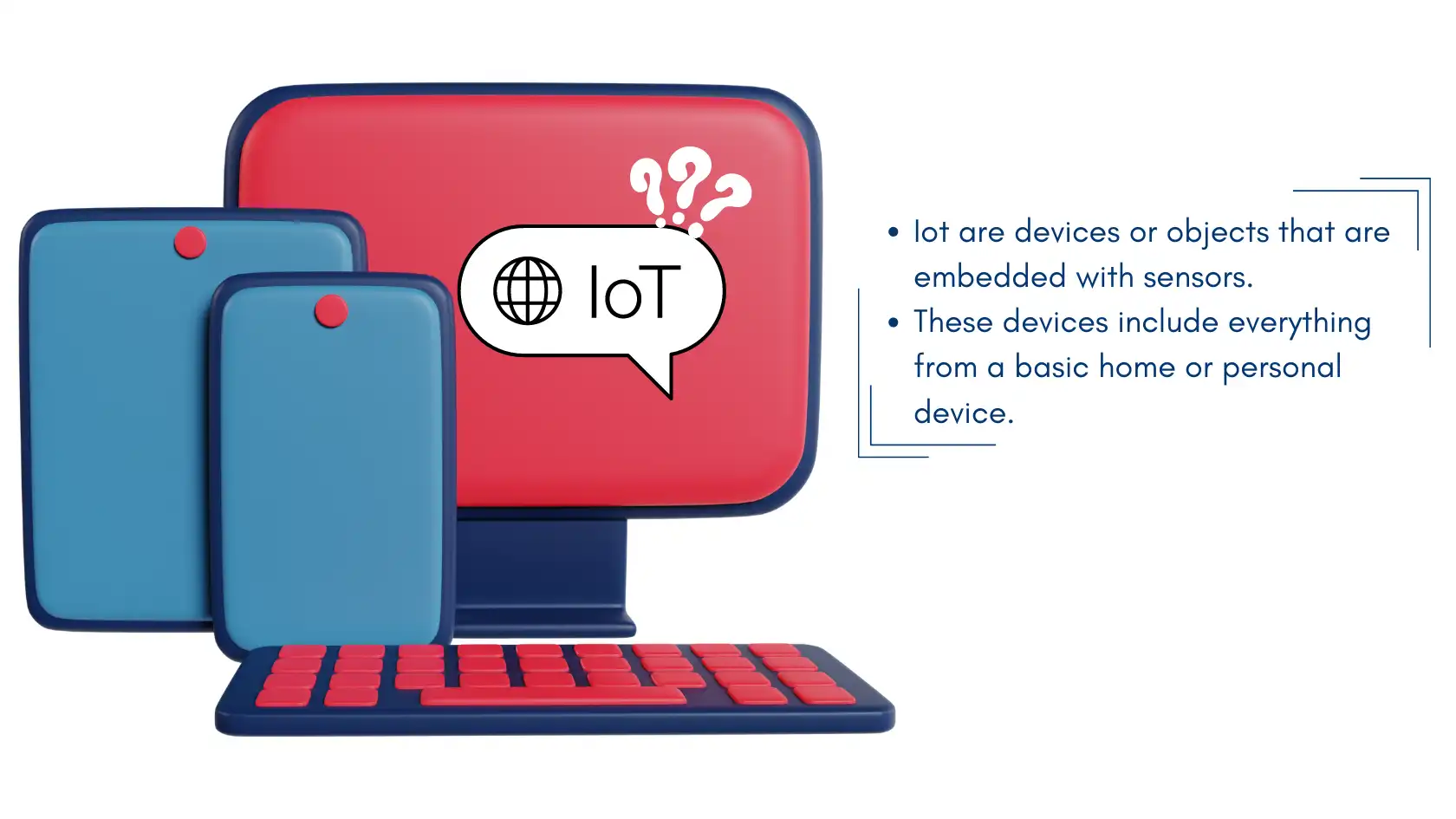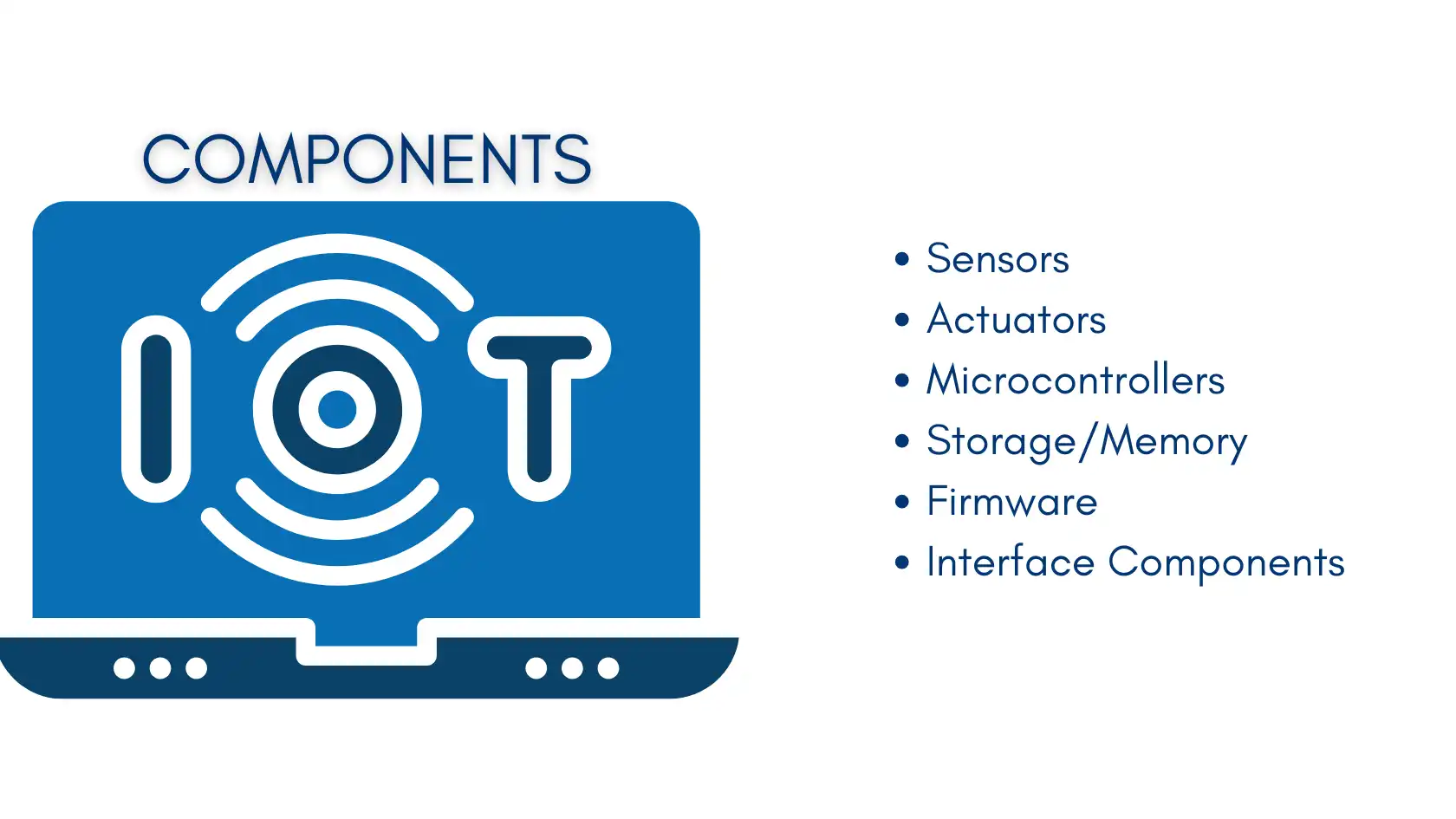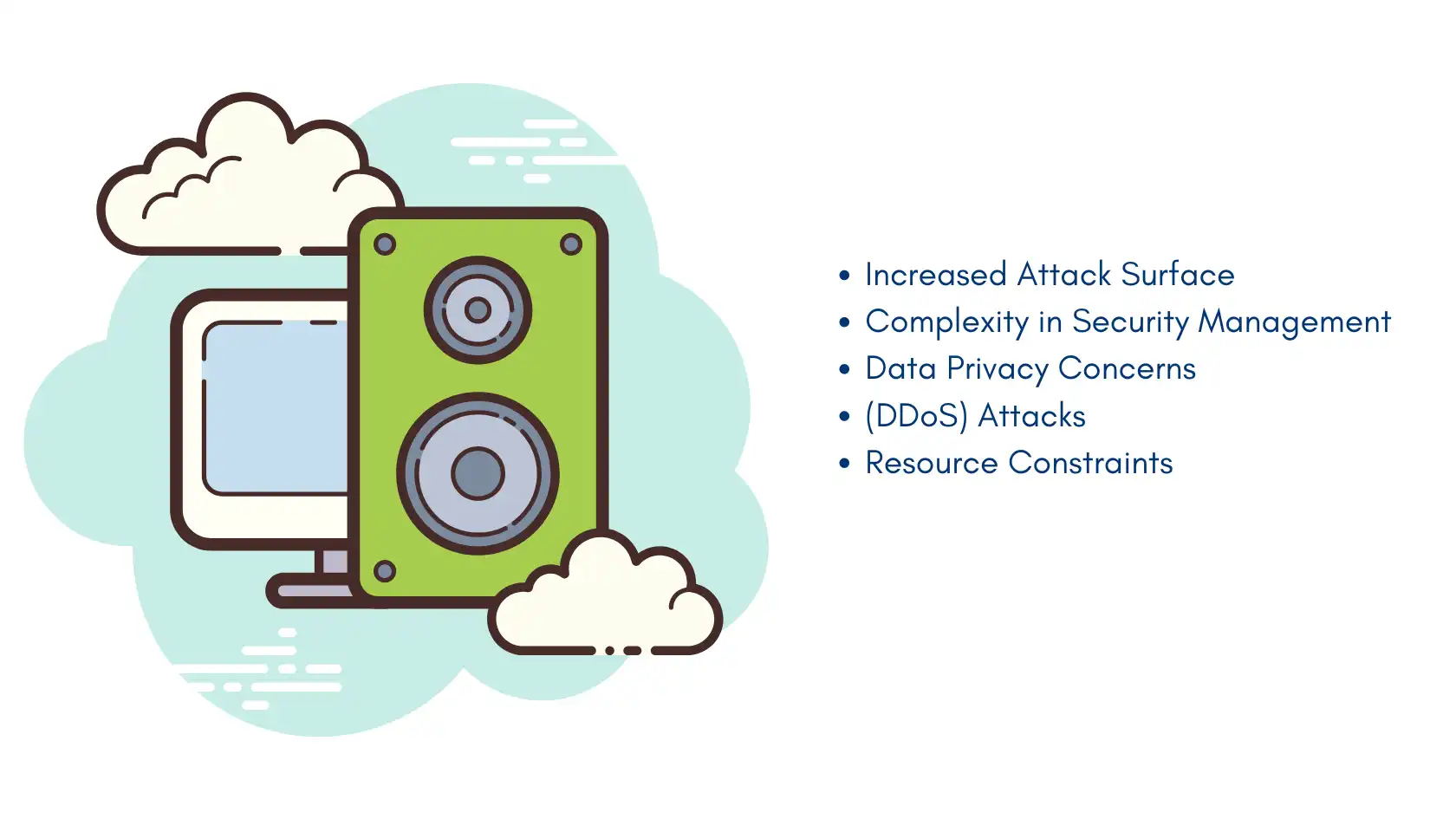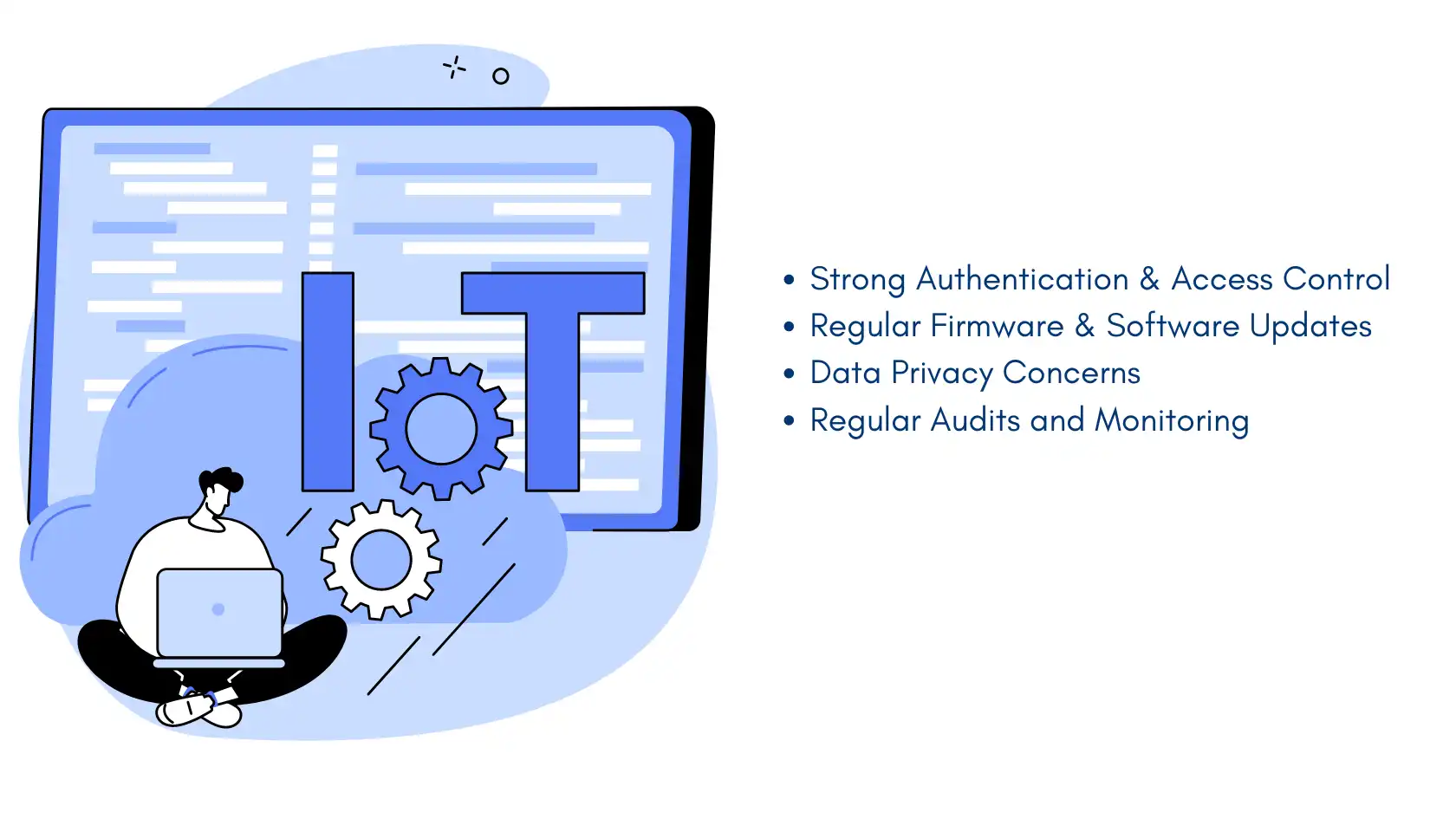What is cybersecurity in IoT devices?” It is a question we hear all the time. We have been playing around with smart home gadgets and wearables for years.
We have seen firsthand how these nifty devices are shaking up things in the land of cybersecurity.
Remember when cybersecurity was all about protecting your computer and smartphone? Well, those days are long gone.
We are living in a world where our fridges can order groceries, our watches can track our health and our thermostats can learn our habits.
All these cool gadgets are also opening up new doors for the bad guys.
Curious about how your smart coffee maker might be the next target for hackers? Or how AI might be the superhero we need to keep our connected world safe?
Stick around, because we are about to dive into the wild and wonderful world of cybersecurity in IoT devices.
What Are IoT Devices?

IoT or Internet of Things are devices or objects that are embedded with sensors and software that can connect to the internet and share data among other connected devices.
These devices include everything from a basic home or personal device like an internet-enabled toaster or wearable fitness trackers and full-fledged industrial machinery like robots, making IoT cybersecurity a critical consideration in ensuring the safety and integrity of these interconnected systems.
Key Features of IoT Devices
- Connectivity: This is one of the most crucial features, as IoT devices are connected to each other or group through a internet connection.
- Data Collection: Devices gather data from sensors like temperature and humidity in their environment.
- Automation: IoT devices can automate a task based on condition, for example lift up the temperature in room when touch threshold.
- Remote Control: Many IoT devices can be controlled remotely via apps on smartphones or other devices.
- A lot of IoT devices come with remote access capabilities through apps on your smartphone.
- Interoperability: IoT devices can communicate through wireless protocols to a central controller, which in return allows them to work together within the same system.

- Lightning-fast speeds to browse without lag
- Servers in 105+ countries around the globe
- Military-grade security to stay safe online
- Try it risk-free with its money-back guarantee
- Native apps for all major devices
Components Of IoT Devices

Every component has a specified role in the operation of the device, contributing to the overall IoT cybersecurity framework.
In this section, we are going to brief about the main parts of IoT devices:
Sensors
Sensors are simple; the primary role of sensors is to gather data while ensuring IoT cybersecurity.
They sense physical data like temperature, humidity, light, motion pressure, etc., from the environment.
Actuators
The actuators are assigned to perform the tasks with respect to the data send by the IoT system. They transform electrical signals into work.
Microcontrollers/Microprocessors
Microcontroller or microprocessor acts as the brain of any IoT device. It analyzes the sensor information and makes decisions based on them and then controls actuators in a specific way.
Microcontrollers are often used in simpler and single-purpose devices whereas microprocessors would be required for multiple functions.
Connectivity Modules
Connectivity modules provide the ability to use an IoT device for communications with other devices.
Depending on the range, power consumption and data rate difference these modules can use a variety of communication protocols.
Power Management
The power management components are responsible for making the IoT device operation more efficient, controlling and distributing power to prolong the battery life of remote or battery-powered devices.
Ensuring IoT cybersecurity in power management is crucial to prevent unauthorized access to power distribution.
Storage/Memory
These are the places where the device keeps the information gathered from sensors as well as software that is used to run on an IoT device.
The device can have different kinds of memory depending on its complexity. Implementing IoT cybersecurity measures in storage/memory is essential to protect sensitive data from breaches.
Firmware/Software
Firmware is basic-level software that regulates the hardware of an IoT device so it can work. These are the operating system, sensor and actuator drivers, communication protocols and the domain code that signifies how a device acts are all part of it.
Embedded Operating System
Some IoT devices are complex ones that require an embedded OS to handle tasks, memory management and communication. The OS abstracts the application software from low-level hardware.
Interface Components
Interface components can interact with users or other devices which are connected to the IoT device.
The physical interfaces are the buttons and screens, while a wireless interface would be Bluetooth or NFC.
All Of The IoT Devices
Smart Home Devices
- Smart Thermostats.
- Smart Lights.
- Smart Plugs.
- Smart Security Cameras.
- Smart Locks.
- Smart Speakers.
Wearable Devices
- Fitness Trackers.
- Smartwatches.
- Smart Glasses.
Healthcare Devices
- Connected Medical Devices.
- Wearable ECG Monitors.
- Smart Medication Dispensers.
Automotive IoT Devices
- Connected Cars.
- Smart Dash Cams.
- Vehicle Telematics.
Smart Appliances
- Smart Refrigerators.
- Smart Ovens.
- Smart Washing Machines.
Smart Cities and Public Services
- Smart Streetlights.
- Smart Waste Bins.
- Traffic Management Systems.
Industrial IoT (IIoT)
- Predictive Maintenance Sensors: Monitor machinery conditions in real-time, predicting failures before they happen, minimizing downtime.
- Supply Chain Trackers: Provide real-time visibility into the location and condition of goods in transit.
Environmental Monitoring Devices
- Smart Air Quality Monitors.
- Smart Water Leak Detectors.
Smart Retail Devices
- Beacon Technology.
- Smart Shelves.
Agricultural IoT
- Smart Irrigation Systems.
- Livestock Monitoring.
Why is Cybersecurity In IoT Devices Important?
From this point on, they are used more and more as part of our daily life. Also, know the latest trends of cybersecurity as IoT devices continue to evolve; cybersecurity in IoT devices just starts here.
Data Privacy and Protection
Personal Data: IoT devices collect big amounts of personal and sensitive data, including health information, location, financial details and much more.
A security breach can lead to the unauthorized access, theft or even misuse of this data, compromising your privacy.
Data Integrity: Maintain the accuracy and consistency of data collected by IoT devices. Cyberattacks might be managed and data harm induced especially in vital systems like health care or commercial control.
Device Security and Integrity
Vulnerable Devices: IoT devices are such a border area where the IoT ecosystem is still in its growing stage and a lot of small forgotten devices will be vulnerable.
Hackers can take advantage of these vulnerabilities to infect the devices, giving them remote-controlled zombies.
Firmware and Software Exploits: Attackers can write simple scripts to exploit unpatched weaknesses in device software, for unauthorized access or limited DoS attacks on IoT devices.
Systemic Risks and Large-Scale Attacks
Botnets and DDoS Attacks: Hijacked IoT devices can be co-opted into botnet capacities, allowing them to launch massive DDoS attacks.
These attacks are so devastating that websites and services can easily be crippled, even major pieces of critical infrastructure.
Cascade Effect: When an IoT system is hacked, the systems are interconnected with each other it will have a cascade effect within the network leading to widespread disruption.
Critical Infrastructure Protection
Industrial IoT (IIoT): IIn sectors like energy, transportation, and manufacturing, IoT devices are used to monitor and control critical infrastructure.
Cybersecurity in the public sector is crucial because a cyberattack on these systems can lead to the worst outcomes, such as power outages, transportation disruptions, or even threats to public safety.
Smart Cities: As smart cities are the theme of the future, there will be many IoT devices managing utilities, traffic and other public services. Millions of people could be left without important services if these devices are not secure.
Economic Impact
Cost of Breaches: Cyber incidents can result in enormous financial losses stemming from data breaches, disruption to normal business operations, legal consequences and reputational damage.
Regulatory Compliance: Due to growing regulations regarding data protection and cybersecurity, like the GDPR or IoT Cybersecurity Improvement Act, businesses that do not secure their IoT systems will actually get fined by law.
Trust and Adoption
Consumer Confidence: Crucial as the number of IoT devices in our homes, offices and public spaces increases, people have to trust they are secure.
Over time, trust can erode as a result of security breaches which undermines the adoption of IoT technologies.
Business Relationships: IoT device security can also impact relationships in B2B contexts due to correlations between partners and supply chains.
In turn, businesses must secure their devices to maintain trust and operational integrity in the products they use or offer for sale.
National Security
State-Sponsored Attacks: IoT devices can be targeted as part of a state class attack that gather intelligence, disrupt critical infrastructure or cause destruction.
If the IoT is to be a national thing, then securing it should also become a matter of national security.
Impact of IoT Devices On Cybersecurity

Increased Attack Surface
Expanded Network Boundaries: IoT devices are frequently connected to previously one-way-only networks.
Where computers and servers were the only things with network connections. This increases cyber attack surface for the attacker.
Diversity of Devices: This means there is a large attack surface that can range from home smart devices to industrial machinery being used. Security bugs of each device type.
Complexity in Security Management
Heterogeneous Environments: IoT platforms are by nature incomplete, so they need to be flexible and have the ability to expand in order to provide value for a large number of diverse technologies.
Keeping a handle on this diverse environment is difficult but also necessary. Security policies must be able to adapt and cover such broad ground.
Firmware and Software Challenges: IoT devices are not computers so they often run specialized software that is difficult to standardize and layer on updates for.
This makes sure that finding, patching or remediating vulnerabilities is hard and hence exposes the machine to such threats for too long.
Data Privacy Concerns
Collection of Sensitive Data: One example is the massive amounts of data that IoT devices collect, like health or location information. Attackers can access this data and extract PII from it to perform privacy breaches if not properly protected.
Insufficient Encryption: A vast majority of IoT devices do not use strong encryption for data in transfer and storage.
Which makes it easy for cyber criminals to misuse your sensitive information.
Botnets and Distributed Denial of Service (DDoS) Attacks
IoT Botnets: IoT devices are often compromised to form botnets, which then get directed by attackers at the targets of their choice. This can include arranging vast DDoS attacks on networks, incapacitating websites or services, making it crucial to save yourself from DDoS threats.
Notable Examples: The Mirai botnet, targeting IoT devices, executed one of the largest DDoS attacks in history on major websites and internet services worldwide.
Challenges in Device Authentication and Authorization
Weak Authentication Mechanisms: A significant number of IoT devices are rolled out onto the network with default or weak passwords, making them sitting ducks for attackers.
Insufficient authentication mechanisms increase the chance of unauthorized access.
Device Spoofing: Attackers can act as IoT devices and gain unauthorized access to a network, potentially even injecting malicious code.
Resource Constraints
Limited Processing Power: A significant number of IoT devices have incredibly limited processing power, which makes it hard to apply proper robust security measures like advanced encryption or intrusion detection systems.
Battery Life and Energy Efficiency: This is usually related to the way security measures are implemented, since this presumes continuous monitoring or having frequent updates that affects battery consumption so badly at battery consumption.
Impact on Critical Infrastructure
Industrial Control Systems (ICS): IoT devices are increasingly used to make critical infrastructure, such as power grids, water treatment systems and transportation networks more efficient.
A resulting cyberattack on the systems can lead to large-scale outages and pose a threat by endangering public safety.
Smart Cities: In which cities start to Smart technologies Manage traffic, utilities and Public services used IoT devices.
These devices should be secured to avoid any disruptions that could affect the general public.
Emerging Threats and Attack Vectors
Ransomware: IoT devices are increasingly being targeted by ransomware campaigns, whereby attackers encrypt device data or lock you out of your systems until you pays them money.
Physical Security Risks: In the case of hacked IoT devices, there are even physical risks associated with these.
For example, to make it so that security cameras or smart locks could be turned off by an attacker for unauthorized physical access to buildings.
Opportunities for Enhanced Security
Real-Time Monitoring: By connecting more and more of our physical world to the digital, real-time monitoring can help improve cybersecurity by being able to detect anomalies in environments better and respond faster.
Data-Driven Insights: The insights from IOT data will allow NIST to capture network behaviours, vulnerabilities and strengthen the security posture.

Uninterrupted, high-speed browsing, zero logs so your online activity is always private.
Over 7000 people checked out NordVPN in the last month
Security Measure You Should Take

Below are key security measures that should be taken to protect IoT devices and the broader IoT ecosystem:
Strong Authentication and Access Control
- Unique and Strong Passwords: Make sure all of your IoT devices are configured with a unique and strong password. Do not use password which are easy to guess.
- Multi-Factor Authentication (MFA): Use MFA, whenever possible, to successfully confirm user identity through two or more factors.
- Role-Based Access Control (RBAC): Limit access to IoT devices and systems by user role so that only users with administrative permissions can execute essential functions.
Regular Firmware and Software Updates
- Automatic Updates: Automatically update the software and firmware of IoT devices to provide security patches, new features.
- Vulnerability Patching: Continuously monitor and patch known vulnerabilities whenever the patches become available for IoT devices.
Encryption
Data Encryption: Include end-to-end encryption like AES-256 to make sure the exchange of data between IoT devices and other networks or systems as well safeguard information stored on the device.
Secure Communication Protocols: All communication between IoT devices and networks must be encrypted using secure protocols like TLS/SSL.
Network Security
- Segmented Networks: Instead of isolating devices into new VLANs, build them in separate logical networks to keep IoT systems from touching critical infrastructure and data. This serves to potentially reduce the destruction should an IoT device become vulnerable.
- Firewalls and Intrusion Detection Systems (IDS): Use firewalls and IDS to monitor the network traffic of IoT and prevent unauthorized access and malicious activity.
- Disable Unnecessary Services: Turn off any unnecessary service or port in the IoT devices you are using to shrink its attack surface.
Regular Audits and Monitoring
- Security Audits: Perform independent and regular IoT device and network vulnerability assessments to identify any patches or misconfigurations.
- Continuous Monitoring: Implement continuous compliance as well as real-time detection of anomalies for suspicious activity, which helps in responding to possible threats promptly.
Secure Device Boot and Hardware Security
- Secure Boot: Enforce secure boot mechanisms to make sure that IoT devices can only execute trusted and verified software to disallow any running of unauthorized code.
- Trusted Platform Module (TPM): Use hardware-based security modules to store cryptographic keys and make sure that the device authentication is for the correct platform.
Data Privacy Measures
- Minimal Data Collection: Collect only the data that is required for an IoT device to work and avoid exposing personal information unnecessarily.
- Data Anonymization: Use anonymous data where possible to maintain your privacy and ensure compliance with regulations on the protection of personal information.
Security by Design
- Incorporate Security Early: Design IoT devices with security in mind from the start rather than adding it later. Cover best practices for dealing with security issues in this web application, like secure coding practice, proper testing and compliance from tools available.
- Third-Party Security Assessment: Independent security experts are hired to conduct third party assessments of IoT devices in order to detect and remediate any possible threats related with the same.
User Education and Awareness
- Educate Users: Encourage yourself on how to properly set up and use an IoT device. It is necessary that updates are installed frequently along with strong passwords.
- Security Best Practices: Educate yourself on security best practices, including not using public Wi-Fi for sensitive interactions with IoT devices and identifying phishing emails.
Compliance with Regulations and Standards
- Adhere to Industry Standards: Follow well-established industry standards and frameworks like ISO/IEC 27001 for information security management, NIST guidelines on RPMS (Roots of Privacy Management Systems) or IoT cybersecurity.
- Regulatory Compliance: Verify that the IoT deployments stick to regional regulations for example GDPR – The General Data Protection Regulation and other industry-specific or country-specific requirements like IoT Cybersecurity Improvement Act.
Zero Trust Architecture
- Zero Trust Principles: Embrace a new Zero Trust security model in which nothing like not the device, user nor application is trusted by default even if they are inside or outside the network perimeter. Therefore, the device and identity has to be authenticated continuously whenever an access is demanded.
These security measures are necessary to protect IoT devices and networks from the ever increasing number of cyber threats.
With IoT device deployments expanding in consumer and industrial environments, security must be approached proactively.
With the integration of these steps, not only can organizations and you can reduce IoT threats but also gain all possible benefits from it.
What Is The Future Of Cybersecurity In IoT Devices?
Enhanced Security by Design
- Built-In Security: The IoT devices of the future will be less vulnerable to attack because they are designed from scratch with security in mind, rather than as an afterthought. The plan is to employ a security by design approach which will consist of secure coding practices, hardware-based security measures and strong encryption.
- Compliance-Driven Innovation: As legislation like the IoT Cybersecurity Improvement Act and GDPR matures, manufacturers will be required to comply with even tougher cybersecurity protocols spurring innovation in secure IoT design.
AI and Machine Learning for Threat Detection
- Advanced Threat Detection: AI and ML are used to prevent cybersecurity issues long before they become insurmountable. These tools measure a broad range of data created by IoT devices for detecting irregularities, preventing likely attacks and reacting to security incidents.
- Behavioral Analytics: This learns how devices in your environment normally behave and can be great for quickly determining if a device is showing signs of compromise.
Zero Trust Architecture
- Zero Trust Adoption: We predict that we will see a massive shift in IoT cybersecurity with the more common implementation of Zero Trust Architecture. In this model, every device has to continuously prove its identity and do so not only for itself but also for the user who is accessing an application or a resource through it.
- Micro-Segmentation: By applying micro-segmentation in networks, IoT devices can be further isolated, which strengthens IoT cybersecurity by cutting off the pathways for any cyber threat to easily move laterally within a network.
IoT Security as a Service
- Managed Security Services: A large chunk of organizations will hire managed security service providers (MSSPs) to manage IoT securing due the complexity that is involved in operating even a simple IOT ecosystem. These providers can also provide full end-to-end security offerings, ranging from device management to real-time threat monitoring and incident response.
- Security Orchestration: In the future, IoT security will consist of balancing platforms that automatically connect and work with various connected device Networks such as managing connections, monitoring networks etc.
Integration with Emerging Technologies
- Blockchain for IoT Security: With Blockchain technology being integrated within an IOT ecosystem, the security concerns particularly around device authentication, data integrity and secure transactions could be addressed.
- 5G and Beyond: The deployment of 5G and future network technologies will introduce new security challenges but also provide opportunities for increased IoT security through faster, more reliable and secure communication.
FAQs
How will the IoT affect cybersecurity?
What are IoT devices in cyber security?
Are IoT devices the weakest link in cybersecurity?
What is the biggest cyber threat from IoT devices?
What are the 3 major factors affecting IoT security?
Why IoT devices are a point of weakness in the cybersecurity landscape?
Conclusion
What a ride through the world of IoT cybersecurity, huh? From the cool gadgets making our lives easier to the headaches they are giving security experts.
But you know what? We are pretty excited about where all this is heading.
Sure, our smart devices might be opening up new vulnerabilities, but they are also pushing us to get creative with our Cybersecurity In IoT Devices solutions.
It is like a high-tech game of cat and mouse, and Cybersecurity In IoT Devices is something we all need to focus on in this digital playground.
As we look to the future, we can’t help but feel a mix of excitement and caution.
AI-powered security, blockchain authentication and maybe even some tech we haven’t even dreamed of yet, it is all on the horizon.
So, the next time you are chatting with your smart speaker or adjusting your thermostat from your phone, take a moment to appreciate the amazing, connected world we are living in. Stay safe out there and happy connecting.






